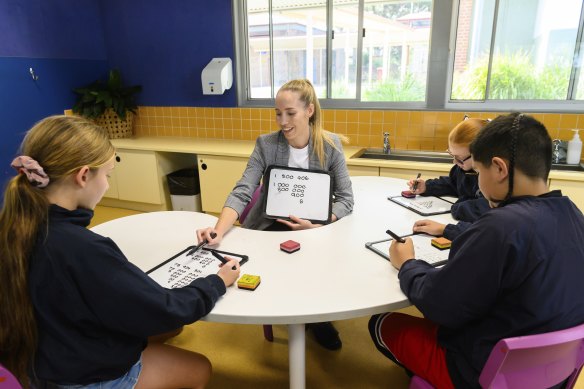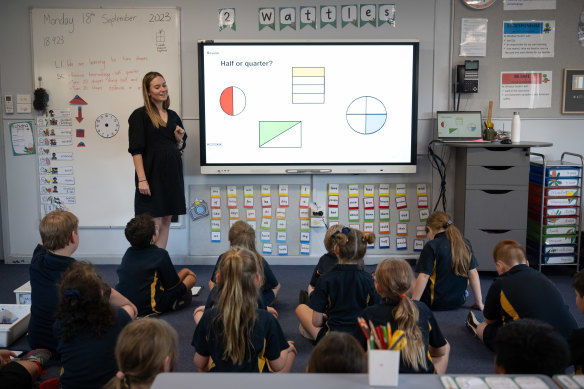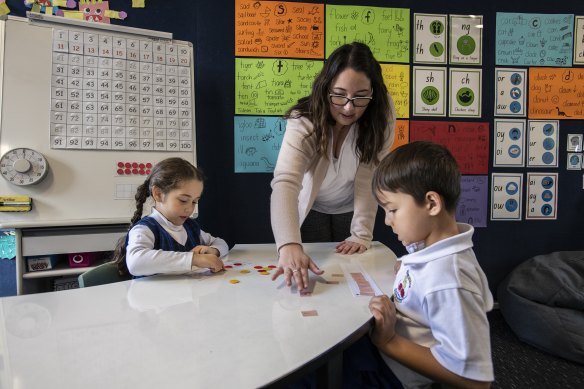By Lucy Carroll
Just over a decade ago, Elise Mountford was teaching a routine year 6 maths class when she asked one of her students to solve a simple equation.
“He became so frustrated at not being able to do the task he knocked over a chair and stormed out of the room. That moment really hit home for me. This student had been at our school for years, but he didn’t feel capable and wasn’t engaged in learning,” she recalls.

Teacher Elise Mountford with year 6 Charlestown South Public students.Credit: Rhett Whyman
Mountford was a teacher at Charlestown South Public at the time, a small public primary school in Lake Macquarie, south of Newcastle.
“The teachers knew something wasn’t working. The school was underachieving and was targeted by the department for reading support. We were putting in huge effort, we cared so much, but it wasn’t paying off,” she says. “We also had a school culture problem where students were disengaged.”
The turning point came in 2015 when Charlestown’s staff and then-principal, Colin Johnson, shifted the school to an explicit teaching model based on the instruction method used at south-east Melbourne private school Haileybury College.
Enrolments increased, and the school later became famed for achieving a dramatic turnaround in maths and reading results. In the five years to 2021, the school lifted its proportion of students in the top two NAPLAN bands from 34 to 79 per cent. Several years ago, it outperformed selective private school Sydney Grammar in year 3 writing.
“We brought in ‘warm-up’ sessions at the start of class and reviews at the end [of lessons] that checked students’ knowledge of concepts. Students became so much more engaged,” Mountford says. “We had been trapped in this cycle of needing to reteach all the time. And that disappeared.”
The change in approach was backed by research into cognitive load theory and a 2014 NSW Education Department analysis that showed students who experienced explicit teaching outperformed those who did not.
Mountford says teachers gave students clear instructions and broke down information into bite-sized chunks to avoid children quickly forgetting what they had been taught. Teachers check for understanding constantly to ensure students master a topic before moving to independent or inquiry learning, she says.
While overhauling the teaching approach, the school also surveyed parents about what they wanted in a bid to boost enrolments. “I spent mornings at the front gate, started a school band, and brought in more sport too,” Johnson says. “We changed the expectations of the community.”
Principles of a maths lesson under this teaching model
- Students review previously taught topics at the start of lessons in daily review sessions
- New concepts and content are taught explicitly first
- Maths topics are ordered so students gradually build understanding
- Students work with teachers to master concepts before completing independent work
- Lessons change and adapt according to students’ needs
- Teachers regularly check for understanding during the class
Charlestown South is now among 30 public primary schools in the Newcastle, Central Coast and Hawksbury regions that have formed a grassroots group known as the Effective and Systematic Teaching Network (EAST) to share lesson plans, resources and hold professional learning sessions for teachers and school leaders.
“It started with Charlestown South, and [Central Coast school] Blue Haven Public, and over a few years we’ve started connecting with other schools that are teaching in a similar way,” Mountford says.
When the new NSW maths syllabus was released in 2022, Mountford and a group of teachers in the EAST network spent six months writing week-by-week lesson plans schools could use alongside the kindergarten to year 6 maths curriculum.
“We wanted to help other schools prepare for the new syllabus. It means teachers don’t need to create lessons from scratch each day, or make up questions the night before,” she says.

Teacher Codi Wood taking a maths class at Windsor South Public. It is one of a few dozen NSW public schools under the EAST network that has shifted their teaching approach in recent years.Credit: Wolter Peeters
The lesson materials form a guide for teachers on each topic – such as division, volume or measurement. “They are fast-paced and interactive, but flexible too. Students are showing the teacher how they are working out problems as they go.”
Ian Short, principal at Vardys Road Public in north-west Sydney, which is part of the network, said the maths program and lesson outlines had helped ease teachers’ workload.
“Studies have been done on how much time can be saved by sharing curriculum resources. When teachers are doing it alone, the workload can be insurmountable,” Short says.
In 2022, the Grattan Institute suggested all Australian schools adopt a whole-school approach to curriculum planning, with a survey showing teachers are often planning on their own and regularly use YouTube and Facebook to source lesson ideas or materials.

Beck Anderson at Vardys Road Public teaching a kindergarten maths lesson.Credit: Steven Siewert
Windsor South Public principal Belinda Bristol, whose school is also part of the network, says embedding daily reviews in maths and literacy lessons in all grades was key in stopping students falling behind.
“In the past, children would go away on holiday and forget everything. Now, we are making sure kids aren’t slipping through the cracks,” Bristol says.
Mountford, now deputy principal at Glendore Public in Maryland, said the EAST network’s maths lesson plans allowed teachers to be “highly responsive to students, but it’s still flexible for the teachers and takes the pressure off with preparation”.
“Once students have very deep understanding of the concepts, the teachers can then give them more opportunities for independent learning and problem-solving,” she says.
Start the day with a summary of the day’s most important and interesting stories, analysis and insights. Sign up for our Morning Edition newsletter.